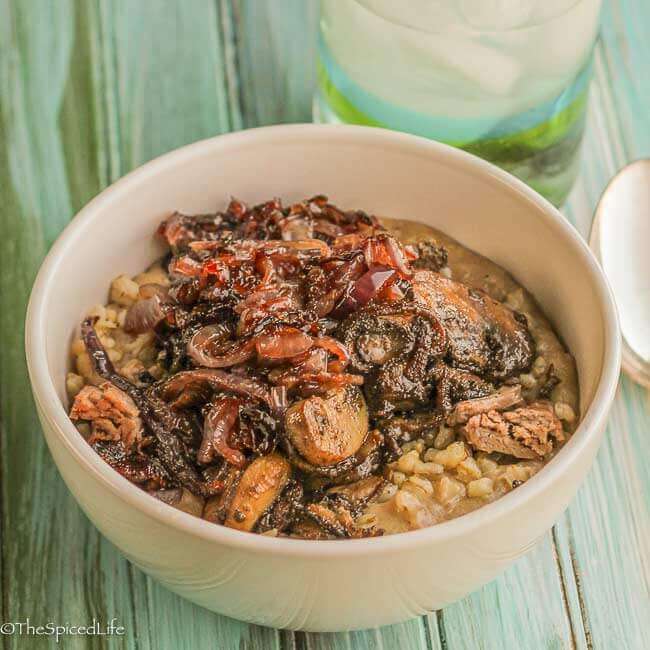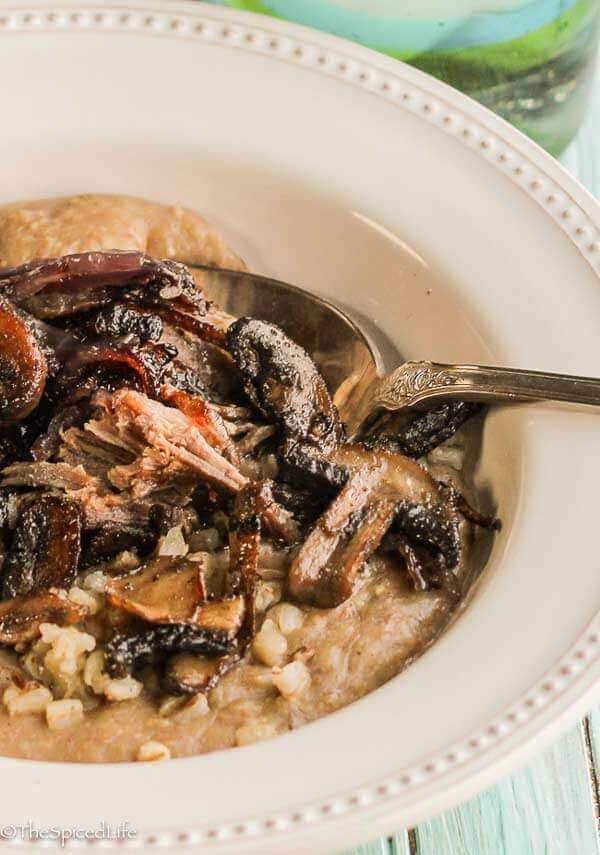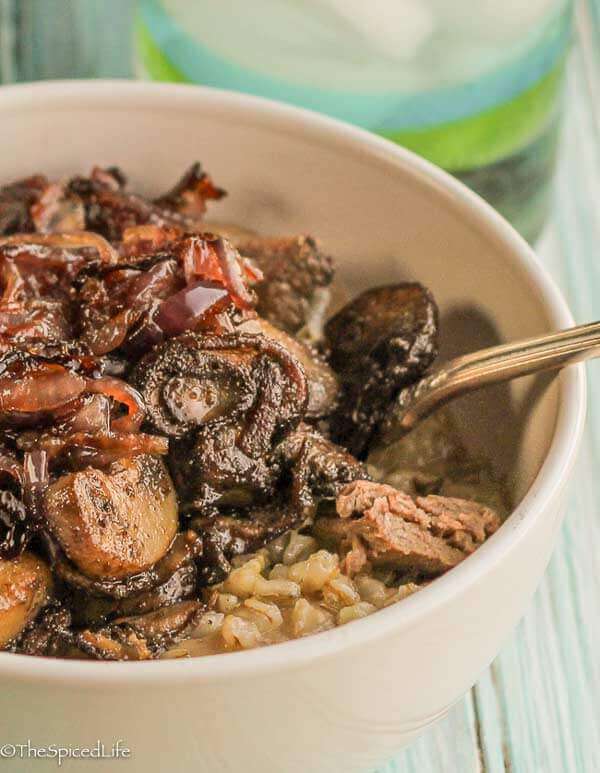Harees (Savory Beef and Wheat Porridge) with caramelized onions and mushrooms is savory and warming, a delicious antidote to chilly nights or bad days. The Food of Oman was sent to me by the publisher in exchange for an honest review. Affiliate links have been used to link to items I am discussing.

OK I will be the first to admit that this dish is pretty outside my wheelhouse. Not the Omani cuisine or the succulent beef, but the porridge aspect. Call it a quirk, but when I discover a new cuisine I often want to try the dish I can least imagine. The one that would broaden our horizons the most. It probably drives my family kids nuts. But they are good sports about it, and I think it is good for us.
So anyone who knows us, knows we like our oatmeal chewy. Like really chewy. No porridge here. Or polenta. Or creamy oatmeal. So what drew me to this meal? Two things: the idea that the meat had cooked down into the porridge and the fact that it was pretty different from any food I had imagined as “Middle Eastern.” However, knowing our preferences, I decided to remove some of the beef and wheat earlier in the cooking process, and serve them on top with the caramelized onions and mushrooms.
The verdict? Delicious. Probably not a repeater as written exactly, just because I would be more likely to braise the beef for a shorter time and serve it on less cooked chewy pearled whole wheat. But the flavors were amazing, rich, warm and comforting.

I made this dish pretty much according to recipe, except I added the mushrooms. I did a little digging, and mushrooms are not unheard of in the Middle East. One of the things that Felicia Campbell emphasizes throughout The Food of Oman: Recipes and Stories from the Gateway to Arabia is make it to taste! Every region and every family is different. She refers to Harees as Arabian Gulf “soul food,” so I figured if mushrooms are soul food to my family, then they belong! Plus they added more chew and are fantastic with beef.
Now about The Food of Oman, the entire book. I am in love. Everything about it. See how it got top billing up there in the title? Forget about the dish (although don’t, not really), this book is amazing. First, the premise for how Felicia Campbell fell in love with the Middle East is an interesting story within itself–she fell in love while deployed in Iraq as a private in the United States army. Something about that just reaffirms my belief in humanity, that she could see through everything she was experiencing in Iraq to discovering that she loved the people there, and their culture and cuisine. So she came home to get a degree in food studies with a Middle Eastern focus.
Those studies led her to the Sultanate of Oman, which leads me to my next reason for loving The Food of Oman so much. Now before reading this book I could not have picked Oman out on a map. My world geography is deplorable, and the current state of the Middle East does not help, as the troubles in other areas drown out the more sane and attractive areas of that part of the world. So anyway, Oman. It is located in the far east of the Middle East, and on a map it is basically across from India. Its many important ports made it a crucial location on spice routes–which means its cuisine is more influenced by spices than other Middle Eastern locales.
That same crucial importance led to Oman being conquered by the Portuguese and then the Persians–but it also in turn meant that when Oman gained its independence it became a powerful empire in its own right (think 18th and 19th centuries), including parts of west India and east Africa. You can imagine the pitter pattering of my heart at this line in The Food of Oman: “The foods of Oman were a wonderfully bizarre mash-up of Bedouin rice and meat, South Asian curries, and East African vegetables spiked with coconut milk, hot chiles, and lime.” (p. xiv)
How did I not know this cuisine existed? I requested this book to review on a whim, based on the fact that I am always open to exploring new cuisines. And I discovered a potential obsession. The Food of Oman is amazing, and the Sultanate of Oman has moved to the top of my “must visit” list. In the meantime I will have to console myself with making everything in the book. Stay tuned!


- 2 cups shelled/pearled whole wheat berries
- 1 1/2 lbs beef (a braising cut such as chuck or brisket)
- salt and pepper to taste
- 1 t ghee, plus more later
- 2 cinnamon sticks
- 10 cups water, plus more if necessary
- 1 T kosher salt, plus more to taste
- 4 T ghee, divided
- 1 t cumin seeds
- 2 red onions, thinly sliced
- 1 lb sliced crimini mushrooms
- 1 t ground coriander
- 1/2 t ground cardamom
-
Cover the whole wheat berries with water and set aside to soak overnight.
-
Season the beef with salt and pepper all over.
-
Using a cooktop-safe slow cooker insert or a heavy bottomed pot, melt the ghee on medium heat and add the beef with 2 cinnamon sticks. Brown on all sides, 5-7 minutes per side.
-
Add the 10 cups of water and place the insert in the slow cooker on low (or transfer the ingredients from the pot to the slow cooker). My slow cooker can be set for quite a few hours--the goal here is to make sure it keeps cooking until you can deal with it in the morning. I think for me that was 14 hours.
-
The next day, in the morning, drain the wheat berries and set aside. Remove the beef to a cutting board and shred.
-
Reserve about a cup of shredded beef and place it in a sealed container in the fridge.
-
Add the wheat berries along with the rest of the shredded beef and 1 tablespoon of kosher salt back into the slow cooker. Add a little more water if the wheat berries are not submerged.
-
Cover the slow cooker and cook on low for 6-8 hours or high on 3-4 hours, whichever works best for your schedule. Check halfway through and make sure it still has enough water to not burn (because it is a slow cooker, it may very well not, whereas if done in the oven it might). If desired, you can also remove some chewy wheat berries at this point and place them with the reserved shredded beef in the fridge.
-
About 45 minutes before dinner, begin the onions and mushrooms.
-
Heat 2 tablespoons of the ghee in a nonstick skillet over medium high heat. Add the cumin seeds and roast. When they have darkened and are fragrant, about 30-60 seconds, add the onions with a pinch of salt. Cook, stirring occasionally. If they start to scorch add a sprinkle of water.
-
After they have caramelized to golden brown, add another tablespoon of ghee with half the mushrooms. Add a pinch of salt and cook, stirring.
-
When the mushrooms have released their water and are browning, add the rest of the mushrooms with another pinch of salt. Cook, stirring, until the onions and mushrooms both have browned.
-
Add the coriander and cardamom and stir through. Add the reserved shredded beef (and chewy wheat berries, if you have them) and heat through. Melt the last tablespoon of ghee into the dish. and remove from the heat.
-
Because I wanted to fully experience this dish as an integrated porridge, I chose to use an immersion blender before serving (Campbell's suggestion). However, you could also whip and mash the porridge with a wooden spoon for more texture.
-
Taste for more salt, but realize you have salted the onions and mushrooms too.
-
Serve, topped with the caramelized onions and mushrooms, including the shredded beef.
For the collage lovers….


OMG — I should not be reading food blogs this late at night because I just want to eat it all! Overall, I love middle eastern cuisine, but with a strong spice presence? Sounds right up my alley! Pinned to make in January after the holiday cookie craze is done and over with! Cheers!
This looks and sounds fabulous! I love Middle Eastern cuisine and this dish is just pure comfort.
This dish looks like every bite melts in your mouth, the porridge idea sounds fantastic, so many textures in just one spoonful I want some =)
I’m always interested in learning about the foods of different cultures! This sounds like a great dish to try!
Fantastic review, makes me feel like gobbling up everything!
As a longtime hot cereal hater (please don’t hate me for it – to me, it just tastes like wallpaper paste), when I read porridge, I thought of breakfast cereal and almost passed this post by. So glad I didn’t. I think porridge is a misnomer for this – it sounds to me like a fragrant and wonderful stew. Plus, I learned about Oman, a place that I hear of occasionally but knew less than nothing about. What a great book, a great post and a wonderful recipe – score!
Wow, Laura, I am totally craving this dish and I want the cookbook! And I loved your whole post. Thanks for the great recipe and review!!